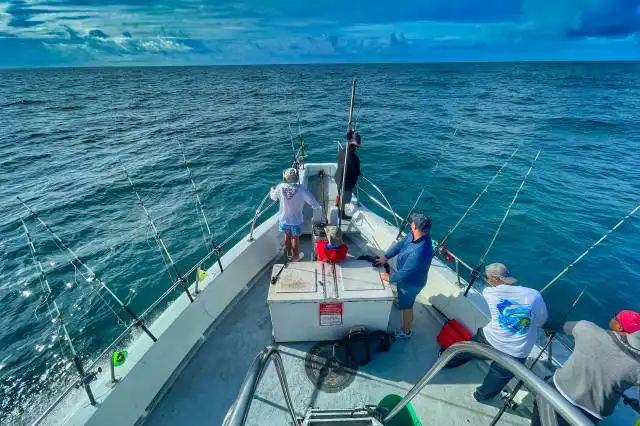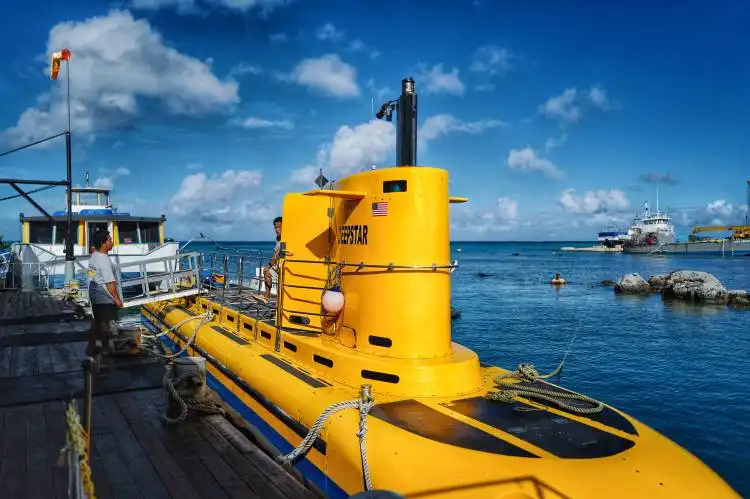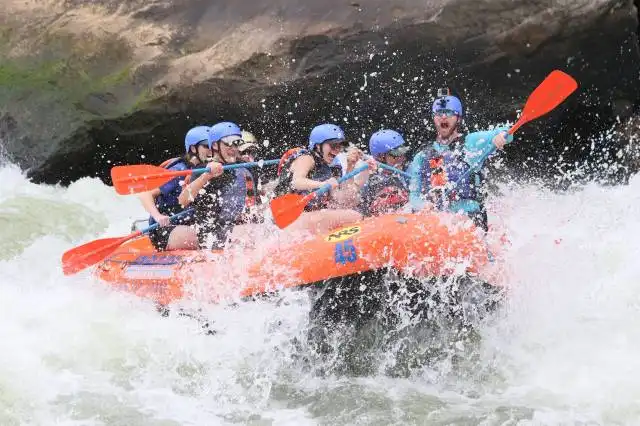Start a Snorkeling Business
Harnessing the Ocean's Charm: Unfolding the Profitable Venture of a Snorkeling Business
| Updated


SNORKELING BUSINESS
Dive into the world of entrepreneurial success with a snorkeling business, a niche yet thrilling venture teeming with possibilities. This business not exclusively cruises you through tour operation but also elegantly combines retail by selling or renting snorkeling gear. Expose adventure seekers to the serene beauty lurking beneath the water's surface, and you might just find your profits surfacing in exciting waves. With the right location and business growth strategies, this could be your ticket to turning a passion for marine exploration into a profitable business!
Jump to Business Plan
RELATED BUSINESS IDEAS
Browse ALL Hospitality & Leisure Ventures Business Ideas
Discover Your Perfect Domain
Unlock the door to your online success with our hand-picked selection of premium domain names. Whether you're starting a new venture or rebranding an existing one, the right domain can set the tone for your digital presence. Browse through our curated list, each with its unique potential to enhance your brand's visibility and credibility.
SNORKELING MINI BUSINESS PLAN
This a quick reality check to help you identify the strengths and weaknesses of your business concept before you dive in.
Expected Percent Margin:
- Gross Margin: 60-70%
- Net Profit Margin: 15-25%
Earnings Expectations:
- Daily Earnings: $100 - $300 (Low Season), $300 - $900 (High Season)
- Weekly Earnings: $700 - $2,100 (Low Season), $2,100 - $6,300 (High Season)
- Monthly Earnings: $3,000 - $9,000 (Low Season), $9,000 - $27,000 (High Season)
- Annual Earnings: $60,000 - $200,000
Actions to Hit Those Numbers:
Equipment and Facility Management:
- Initial Investment: At least $10,000-$20,000 for quality snorkeling equipment and safety gear.
- Maintenance: Regular maintenance and replacement of equipment.
Marketing and Customer Acquisition:
- Website: Ensure you have a user-friendly website detailing your tours, prices, and contact information.
- Social Media: Post daily on platforms popular with travelers (Instagram, TripAdvisor, etc.).
Service Execution:
- Staffing: Employ experienced, certified snorkeling guides.
- Training: Train staff in providing excellent customer service to ensure positive reviews and referrals.
Cost Control:
- Location: Preferably, your business should be located near the beach with high tourist traffic.
- Insurance: Secure comprehensive liability insurance to protect your business.
Business Operations:
- Booking Management: Ensure a streamlined booking process (both online and offline) for your services.
- Safety Measures: Consistently adhere to safety regulations and guidelines
- Tours Volume: Aim for 3-5 snorkeling tours per day, each with a capacity of 10-20 tourists.
Again, these are general estimates and can vary significantly based on various factors such as location, season, and the specifics of your business model. Always seek advice from a business consultant or financial advisor for more tailored guidance.
NOT WHAT YOU HAD IN MIND? Here are more ideas



Browse ALL Hospitality & Leisure Ventures Business Ideas
Grab Your Business Website Name
Before you get caught up in the whirlwind of setting up your business, invest in a domain name. It's a small but significant step that lays the foundation for your brand and makes it easier for customers to find and trust you. Just like you wouldn't build a house without securing the land first, don't build a business without securing your domain name.
"Why? Can't that wait?" Here's why it shouldn't
Step 1: Determining if a Snorkeling Business is Right for You
Startup Expenses
Starting a snorkeling business requires a significant investment of both time and money. Before deciding to pursue this venture, it is important to understand the costs associated with getting the business off the ground. Startup expenses include the cost of equipment such as snorkeling masks, fins, wetsuits, and other necessary gear. Additionally, you will need to consider the cost of renting a space for the business, obtaining any necessary licenses or permits, and advertising and marketing costs. It is important to research these costs thoroughly so that you can accurately estimate the amount of money you will need to start the business.
Ongoing Expenses
Once the business is up and running, there are still ongoing expenses to consider. These include the cost of maintaining and replacing equipment, insurance, and any other fees associated with running the business. Additionally, you may need to pay employees, rent a space for the business, and pay for any necessary permits or licenses. It is important to understand the ongoing costs associated with running the business so that you can accurately budget for them.
Examples of Ways to Make Money
There are a variety of ways to make money with a snorkeling business. You can offer snorkeling tours, classes, and equipment rentals. Additionally, you can sell snorkeling gear and accessories. You can also offer other services such as underwater photography or videography. It is important to research the local market and determine which services will be most profitable for your business.
Step 2: Naming the Business
Naming a business is an important step in the process of starting a snorkeling business. It should be something that is memorable and easy to spell. It should also be something that reflects the mission and values of the business. It is important to make sure that the name is not already taken by another business. A good way to do this is to search the United States Patent and Trademark Office database. Additionally, it is important to make sure that the domain name is available. This will make it easier for customers to find the business online.
When coming up with a name, it is important to brainstorm ideas and narrow down the list to a few options. It is also important to get feedback from friends and family. This can help to ensure that the name is memorable and reflects the mission and values of the business. Additionally, it is important to consider the potential for future expansion. A good name should be able to grow with the business.
Once the name is chosen, it is important to register it with the state. This will help to protect the business from any potential legal issues. Additionally, it is important to register the business with the Internal Revenue Service. This will help to ensure that the business is compliant with all applicable tax laws. Finally, it is important to register the business with the local chamber of commerce. This will help to ensure that the business is in compliance with all applicable regulations.
Step 3: Creating a Business Plan
Creating a business plan is essential for any business. It should include a detailed description of the business, the products and services offered, the target market, the competition, the marketing and advertising strategies, the financial projections, and the management team. Additionally, it should include a breakdown of startup costs, ongoing expenses, and ways to make money.
When creating a business plan, it is important to be realistic and honest. The plan should include a detailed description of the business, including the products and services offered, the target market, the competition, and the management team. It should also include a breakdown of startup costs, such as the cost of equipment, licenses, and permits, as well as ongoing expenses, such as rent, utilities, and payroll. Additionally, the plan should include a detailed marketing and advertising strategy, as well as a financial projection of expected income and expenses.
The business plan should also include a detailed description of the management team. This should include the qualifications of the team members, their roles and responsibilities, and how they will work together to achieve the business’s goals. Additionally, the plan should include a detailed description of the marketing and advertising strategies, including the types of advertising and promotional activities that will be used to reach the target market.
Finally, the business plan should include a financial projection of expected income and expenses. This should include a breakdown of startup costs, ongoing expenses, and ways to make money. It should also include a detailed description of the expected income and expenses over a period of time, such as one year or five years. This will help the business owner to plan for the future and make sure that the business is financially viable.
Step 4: Obtaining the Necessary Licenses and Permits
Before starting a snorkeling business, it is important to understand what licenses and permits are needed to legally operate. Depending on the location of the business, the type of licenses and permits needed may vary. Generally, a business license, a sales tax permit, and a permit to operate a boat are required. Additionally, if the business will be providing snorkeling instruction, a special instructor’s license may be required.
Where to Obtain Licenses and Permits
The best place to start when obtaining the necessary licenses and permits is to contact the local government office. They will be able to provide information on what licenses and permits are needed and how to go about obtaining them. Additionally, they may be able to provide information on any additional permits that may be required.
Cost of Licenses and Permits
The cost of licenses and permits will vary depending on the location of the business and the type of licenses and permits needed. Generally, the cost of a business license and a sales tax permit will be relatively low. However, the cost of a permit to operate a boat may be more expensive. Additionally, the cost of an instructor’s license may also be more expensive.
Time Frame for Obtaining Licenses and Permits
The time frame for obtaining licenses and permits will also vary depending on the location of the business and the type of licenses and permits needed. Generally, the process of obtaining a business license and a sales tax permit can be completed relatively quickly. However, the process of obtaining a permit to operate a boat may take longer. Additionally, the process of obtaining an instructor’s license may also take longer.
Step 5: Finding a Location
When choosing a location for a snorkeling business, it is important to consider factors such as access to the water, the availability of snorkeling equipment, and the proximity to potential customers. It is also important to consider the local regulations and zoning laws that may affect your business. Additionally, it is important to consider the cost of renting or purchasing a location, as well as the cost of any necessary renovations or upgrades.
Examples of Possible Locations
Possible locations for a snorkeling business include beachfront properties, marinas, and other waterfront locations. Additionally, some businesses may choose to operate out of a boat, allowing them to travel to different locations. It is also possible to rent or purchase a storefront or office space in order to provide a place for customers to rent equipment and sign up for tours.
Securing a Location
Once you have identified a suitable location, it is important to secure it. This may involve signing a lease or purchasing the property. Additionally, it is important to make sure that the property is properly zoned for a snorkeling business and that all necessary permits and licenses are obtained. It is also important to make sure that the property is properly insured in order to protect your business from any potential liabilities.
Step 6: Purchasing Equipment
When starting a snorkeling business, it is important to purchase the right equipment. The most important pieces of equipment are snorkeling masks, fins, and snorkels. Additionally, you will need to purchase a variety of sizes for different customers. You will also need to purchase wetsuits, life jackets, and other safety equipment. Depending on the type of snorkeling business you are starting, you may also need to purchase boats, kayaks, and other watercraft.
Where to Purchase Equipment
When purchasing equipment for your snorkeling business, it is important to shop around and compare prices. You can purchase equipment from a variety of different retailers, both online and in-store. Additionally, you may be able to purchase used equipment from other snorkeling businesses or individuals. This can help to reduce your startup costs. Additionally, you may be able to purchase equipment in bulk, which can help to reduce costs even further.
Step 7: Advertising and Marketing
Advertising and marketing are essential components of any business, and a snorkeling business is no different. There are a variety of ways to advertise and market a snorkeling business, including traditional methods such as print and television ads, as well as digital methods such as social media and search engine optimization (SEO). Traditional methods are often more expensive, but can be effective if done correctly. Digital methods are often more cost-effective and can reach a wider audience. Additionally, word-of-mouth marketing is also an effective way to spread the word about a snorkeling business.
Develop a Brand
Developing a brand for a snorkeling business is essential for creating a recognizable identity and building customer loyalty. This includes creating a logo, slogan, and other visuals that can be used to promote the business. Additionally, creating a website and social media accounts can help to further promote the business and create a stronger online presence.
Utilize Local Resources
Utilizing local resources is a great way to advertise and market a snorkeling business. This includes partnering with local businesses and organizations, as well as attending local events and festivals. Additionally, utilizing local media outlets such as newspapers, radio, and television can be a great way to reach a local audience.
Develop a Pricing Strategy
Developing a pricing strategy is essential for any business, and a snorkeling business is no different. It is important to consider the cost of goods and services, as well as the cost of labor, when developing a pricing strategy. Additionally, it is important to consider the competition and the local market when setting prices. It is also important to consider the potential for discounts and promotions, as these can be effective ways to attract customers.
Step 8: Hiring Employees
When hiring employees for a snorkeling business, it is important to make sure that they are knowledgeable about the sport and have a passion for it. It is also important to make sure that the employees are certified in CPR and first aid. Additionally, it is important to make sure that the employees have the proper certifications and licenses to operate the snorkeling equipment. It is also important to make sure that the employees have good customer service skills and are able to handle customer complaints in a professional manner.
Training Employees
Once employees have been hired, it is important to provide them with adequate training. This should include safety training, customer service training, and training on the proper use of the snorkeling equipment. Additionally, it is important to provide employees with an overview of the business and the services that it offers. This will help ensure that the employees are knowledgeable about the business and can provide customers with the best possible experience.
Establishing Policies and Procedures
Once the employees have been hired and trained, it is important to establish policies and procedures for the business. This should include policies and procedures for customer service, safety, and the proper use of the snorkeling equipment. Additionally, it is important to establish policies and procedures for the handling of customer complaints and disputes. This will help ensure that the business is run in a professional and efficient manner.
Establishing Compensation
When establishing compensation for employees, it is important to consider the type of work that they will be doing and the level of responsibility that they will have. Additionally, it is important to consider the cost of living in the area and the cost of providing benefits to employees. This will help ensure that the employees are adequately compensated for their work and that the business is able to remain profitable.
Step 9: Opening the Business
Opening a snorkeling business requires a lot of preparation and planning. It is important to have a plan in place to ensure that the business is successful. First, it is important to determine the best location for the business. This should be based on the target market and the type of services that will be offered. It is also important to consider the cost of renting or purchasing a space for the business. Additionally, it is important to consider the cost of any necessary equipment, such as snorkeling gear, boats, and other necessary items.
Second, it is important to consider the necessary permits and licenses for the business. Depending on the location, different permits may be required in order to operate a snorkeling business. It is important to research the local laws and regulations to ensure that the business is compliant. Additionally, it is important to consider any insurance requirements for the business.
Third, it is important to create a marketing plan for the business. This should include a plan for advertising the business and reaching out to potential customers. Additionally, it is important to consider any online presence that the business may have. This could include creating a website and social media accounts to promote the business.
Finally, it is important to create a plan for managing the business. This should include a plan for hiring employees, managing finances, and tracking customer feedback. Additionally, it is important to create a plan for tracking the success of the business. This could include tracking customer reviews, sales, and other metrics. With a plan in place, the business can be opened and ready to serve customers.
EXPLORE MORE CATEGORIES
Browse ALL Business Idea Categories
TAKE THE NEXT STEPS










